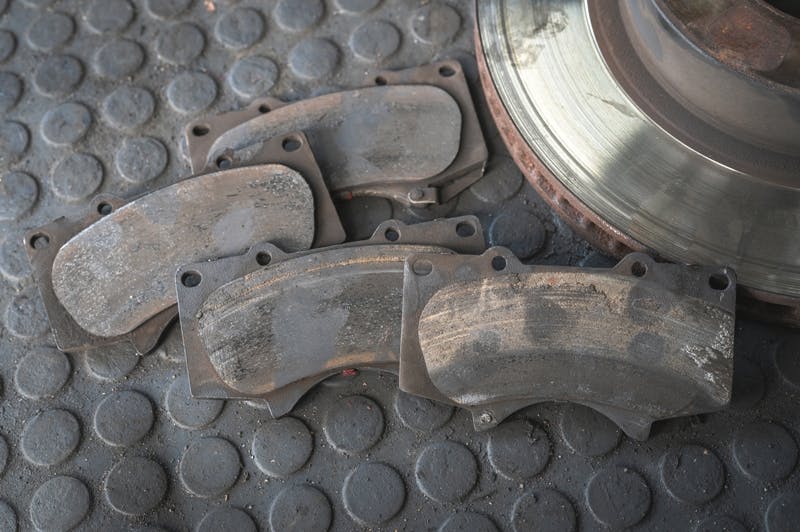Why do Brake Pads Wear Unevenly?

In fully functional brake systems, the inboard and outboard brake pads usually wear down at about the same rate, but there are several reasons why one brake pad on one wheel can wear faster than the other pad on the same wheel.
As a practical matter, floating brake calipers are designed to “float” on their mountings, which means that the hydraulic pressure calipers generate is shared equally between both pads in the caliper. However, in some caliper designs, the body of the caliper is fixed to its mounting, but because these types of calipers are fitted with pistons on either side of the brake rotor, the caliper represents a closed system, in which the pressure is equal at all points in the system when a driver applies the brake. Therefore, the hydraulic pressure is shared equally between the two brake pads in the caliper.
In practice, though, floating calipers are far more prone to binding and sticking than fixed calipers, and here is why-
Floating calipers slide on two pins, which allows for movement of the caliper as the brake pads wear down. However, since brake pads wear down very slowly, floating calipers are essentially stationary on their sliding pins for relatively long periods, with only the pistons moving by deforming the flexible seals in the body of the caliper that contain the hydraulic pressure that pushes the pads against the brake rotors.
Nonetheless, as the brake pads wear down over time, the caliper should slide over the pins to a) maintain the optimal clearance between the brake pads and the brake rotors, and b) maintain the distance that the brake pedal travels during brake applications.
Although the sliding pins are fitted with rubber seals to prevent dust, water, sand, and other contaminants from entering the pins’ bores, it is very easy to damage these seals during brake pad replacements. When this happens, all manner of contaminants can enter the bores, thus causing the calipers to bind or stick on the pins.
Moreover, since the pistons on floating calipers are always on the inboard side of the brake rotors, most of the hydraulic pressure during brake applications acts on the inboard brake pad, since the caliper can no longer slide on the pins to equalise the hydraulic pressure. This condition is commonly known as “brake drag”, and in severe cases, the inboard brake pad can wear down two or three times as fast as the outboard pad.
In the case of fixed calipers that do not “float”, brake drag is typically caused by caliper pistons that have become frozen in place because of corrosion, but it is important to note that caliper pistons do not move through their seals during braking. The pistons in both floating and fixed calipers typically only move a few tenths of a millimetre during brake events, so the seals that contain the hydraulic pressure in the calipers deform to allow the pistons to act on the brake pads.
When pressure is removed from the brake system, the flexible seals return to their original form, which then a) draws the pistons back toward their rest position, and b) restores the required clearances between the brake pads and the brake rotors. Thus, if one piston becomes frozen in place through corrosion or some other cause, most, or all of the brake pressure will only act on the piston that is free to move, which typically causes one brake pad in a caliper to wear much faster than the other.
Apart from seized or defective brake calipers, brake drag can also be caused by-
Defective flexible brake hoses
Flexible brake hoses, such as those found on the front wheels of most cars, allow the free movement of the wheels during suspension movements and steering inputs while allowing hydraulic brake pressure to be transmitted to the calipers on the front wheels.
However, the steel fittings on the end of the rubber hoses are crimped onto the hose, and over time, the inner layers of the brake hose begin to separate from the reinforcing layers at the point where the steel fitting ends inside the hose.
When this happens, the detached inner layers of the hoses begin to act like one-way valves in the sense that they allow brake pressure to pass into the calipers, but not to pass back through the restriction to relieve the brake pressure. Since the brake pressure is effectively trapped inside the calipers, the brake pads remain in contact with the brake rotors, which can cause the brakes to overheat severely.
It is worth mentioning, though, that damaged brake hoses typically cause both brake pads in a fixed caliper on an affected wheel to wear down at much the same, albeit accelerated rate, but it often happens that one brake pad wears more quickly than the other in some floating calipers.
Damaged or worn wheel bearings
When wheel bearings are worn, damaged, or adjusted incorrectly, the bearing no longer maintains the wheel’s plane of rotation perpendicular to the centreline of the axle. Therefore, the change in an affected wheel's plane of rotation also changes the brake rotor's plane of rotation relative to the centreline of the brake caliper.
When this happens, the brake rotor exerts a constant pressure on one brake pad because the brake rotor is not rotating in the middle of the caliper. In such cases, the affected brake pad wears down at a greatly accelerated rate, and so it is not uncommon to see an affected brake pad wearing down to its steel backing plate in only a few thousand kilometres of use.
